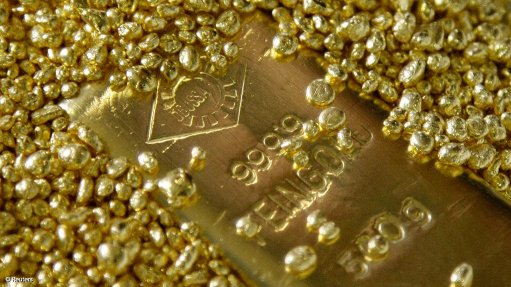
JOHANNESBURG (miningweekly.com) – Following Moody’s large-scale review of the global mining sector in January, the ratings agency expected the price of gold to remain volatile.
In a report released on Tuesday, Moody’s anticipated capital spending for gold miners – which fell to $8-billion in 2015 from $23-billion in 2012 – to remain at diminished levels.
With the steady decline of gold prices since a peak at nearly $1 900/oz in 2011, producers adjusted their strategies to address debt levels and spending in an effort to respond to the new gold price environment.
Of the 20 precious metal producers that Moody’s rated, 14 had their ratings confirmed, five were downgraded one notch and one was downgraded two notches – a significant contrast to the base metal sector, which saw 16 multi-notch downgrades among 41 total rating actions.
“Unlike base metals, supply and demand were not the driving factors for gold prices. Gold is still considered a safe-haven investment, though it fluctuates in response to global macroeconomic factors. Gold's role as a value store means it is subject to speculation and volatility based on market and interest-rate fluctuations. We expect it to remain highly volatile, with limited upside,” the report noted.
Debt reduction became a priority among many gold producers, with debt levels showing a decline in 2015 as a result of asset sales, as well as free cash flow being used to reduce absolute debt.
Two of Moody’s rated companies – Barrick Gold and Yamana Gold – announced debt reduction targets this year.
Their negative outlooks indicated the risk around each company's ability to execute on their planned debt and leverage reductions in 2016.
Moody’s expected AngloGold Ashanti and Newcrest Mining to maintain their leverage levels, with the possibility of some additional deleveraging.
In addition to absolute debt reduction, gold companies have sought to reduce both operating and capital costs to generate positive free cash flow.
Cash costs had declined by over $100/oz from 2013 amounts within Moody’s sphere of rated companies.
The ratings agency believed there was an opportunity for additional cost reductions in 2016 and 2017, resulting from a continued focus on achieving operational efficiencies at mines, combined with lower fuel costs and depreciating currencies in many gold mining jurisdictions.
Despite the focus on cost efficiencies, most of the industry's cash savings resulted from reduced capital expenditures.
“In 2015, capital spending was only 35% of the total spent in 2012 for our universe of rated gold companies. Looking forward over the next two years, we expect capital spending to remain at a similarly low level,” the report stated.
With the marked decrease in capital expenditures, the ability of gold producers to maintain their production profiles became a key credit factor and was an important driver of earnings before interest, taxes, depreciation and amortisation and cash flow, should production fall without a corresponding reduction of debt.
The level of gold supply changed slowly, with new mining production estimated to add about 2% to the total gold supply each year and this amount historically being fairly predictable and stable.